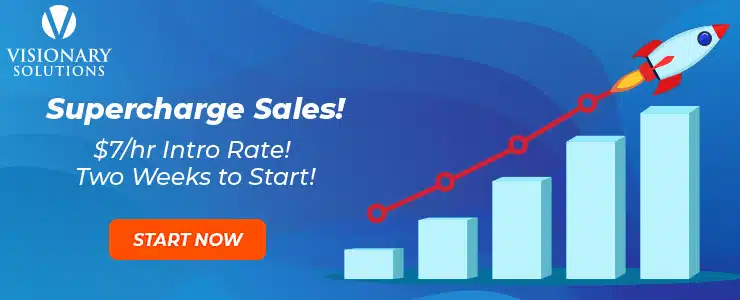In today’s dynamic and digitally-driven business landscape, the concept of inbound sales has emerged as a pivotal strategy for companies seeking to navigate the complexities of modern marketing.
With the internet reshaping how consumers discover and interact with brands, this has become not just a buzzword but a fundamental approach to customer acquisition.
This comprehensive guide explores its nuances, shedding light on its growing significance in the digital age.
As we delve into the intricacies of these strategies, the focal point remains clear: understanding and leveraging their power.
What is Inbound Sales?
This is a transformative approach to the sales process that focuses on creating valuable and meaningful interactions with potential customers.
Unlike traditional outbound strategies, which involve reaching out to leads through methods like cold calling and mass emails, inbound sales centers around attracting and engaging prospects through relevant and helpful content.
In essence, it’s about drawing customers in rather than pushing a message out. Its core philosophy is rooted in building relationships, understanding customer needs, and providing solutions.
Its significance in the context of modern business practices cannot be overstated. With the advent of the internet and the evolution of consumer behavior, the traditional sales model has undergone a paradigm shift.
In today’s digitally connected world, consumers have access to a wealth of information, and they prefer to research and make informed decisions on their own terms. It aligns perfectly with this shift, as it empowers firms to be present where their customers are—online.
The inbound sales meaning revolves around the concept of being helpful and providing value at every stage of the buyer’s journey. Rather than bombarding prospects with pitches, businesses employing these strategies focus on creating content that addresses the pain points and questions of their target audience. This not only builds trust but positions the business as an authority and a valuable resource in the eyes of the consumer.
It goes beyond just attracting leads; it encompasses the entire customer experience. From the initial awareness stage to the decision-making phase, It is about nurturing leads by delivering relevant content, personalized communication, and timely solutions. The goal is to guide potential customers organically through the sales funnel, fostering a relationship that goes beyond a one-time transaction.
Inbound Sales vs Outbound Sales: A Comparative Overview
In the ever-evolving landscape of sales methodologies, the dichotomy between inbound and outbound sales strategies stands out prominently.
Let’s delve into a comparative analysis of these two approaches to understand their nuances and explore the distinct advantages that it bring to the forefront.
Focusing on Attraction and Engagement
Inbound sales methodology revolves around drawing potential customers in by creating valuable and tailored content.
This content, whether in the form of blog posts, social media updates, or informative videos, is strategically designed to address the pain points and needs of the target audience. The underlying philosophy is to attract, engage, and convert leads into customers organically.
One of its primary advantages is the heightened level of engagement it fosters. When potential customers actively seek out information that aligns with their interests or challenges, the engagement rate tends to be notably higher compared to outbound methods.
This engagement is not forced but arises from a genuine interest in the content provided, creating a more receptive audience.
The Traditional Outreach Approach
Conversely, outbound sales involve proactively reaching out to potential customers, often through cold calling, emails, or traditional advertising.
While it has been a longstanding practice and can yield results, it operates on the premise of initiating contact, sometimes with an audience that may not have expressed a specific interest in the product or service.
Advantages of Inbound Sales
Its key advantage lies in its alignment with the evolving preferences of modern consumers. In the digital age, they prefer to make informed decisions at their own pace. Inbound sales respect this process by providing valuable information when potential clients are actively seeking it.
Moreover, it allows for a more nuanced understanding of their needs. Through tracking online behaviors and interactions, businesses can gather insights into what they are looking for, enabling them to tailor their approach more precisely.
Data-Driven Insights: The ROI Game-Changer
When it comes to Return on Investment (ROI), inbound sales has demonstrated its prowess in delivering tangible results.
Consider the scenario where a company invests in creating high-quality content that addresses specific pain points of its target audience. This, optimized for search engines, not only attracts organic traffic but also nurtures leads through the sales funnel.
According to HubSpot’s State of Inbound report, these practices are 3.5 times more likely to deliver higher ROI compared to alternative methods. This substantial difference stems from its very nature, where efforts are concentrated on a receptive audience actively seeking information.
For instance, a blog post addressing common challenges in a particular industry not only attracts relevant leads but also positions the company as a thought leader. As these leads progress through the sales funnel, the initial investment in content creation continues to yield returns by contributing to their conversion into customers.
In contrast, outbound strategies often face challenges related to audience receptivity. Cold calls or unsolicited emails may not always reach a receptive audience, leading to lower conversion rates and, consequently, a lower ROI.
Real-world Examples: Inbound Triumphs
Consider the success story of a software-as-a-service (SaaS) company that invested in creating in-depth, educational content about common issues faced by businesses in their niche.
This content, ranging from webinars to downloadable resources, not only attracted a substantial audience but also positioned the company as an authority in the domain.
As a result, when potential clients were ready to explore solutions, they naturally gravitated toward the company that had been consistently providing value through its sales efforts.
This organic attraction translated into higher conversion rates and a notable increase in the lifetime value of acquired customers.
Exploring the Spectrum of Inbound Sales
The spectrum of inbound sales unveils a rich tapestry of approaches, underscoring the fact that there is no singular, universal method.
The diversity within its strategies reflects the recognition that businesses and customer segments are unique, demanding a nuanced approach for optimal engagement.
From content marketing and social media outreach to search engine optimization (SEO) and personalized email campaigns, its scope is broad and adaptable.
One crucial aspect is its adaptability to various business models. For instance, a B2B (business-to-business) enterprise might find substantial success in content-driven strategies, positioning itself as an industry thought leader to attract potential clients.
On the other hand, a B2C (business-to-consumer) company may leverage the immediacy of social media to engage directly with its audience, fostering a sense of community and brand loyalty.
This acknowledges that what works exceptionally well for one type of business might require tweaking for another, emphasizing the need for a tailored approach.
Moreover, the importance of tailoring strategies to specific customer segments becomes evident. Customer behaviors, preferences, and expectations vary widely.
For instance, younger demographics might be more responsive to engaging visuals on platforms like Instagram, while professionals in certain industries might prioritize in-depth whitepapers or webinars.
Its adaptability allows companies to craft content and engagement techniques that resonate with the specific demographics they are targeting, acknowledging that a personalized approach often yields the best results.
Its flexibility stands out as a defining feature. This allows businesses not only to respond to changing market dynamics but also to experiment and refine their approaches continually.
In a rapidly evolving digital landscape, where consumer trends and technologies can shift swiftly, having a flexible inbound strategy is paramount. Businesses can pivot seamlessly, adjusting their tactics based on performance metrics, customer feedback, and emerging trends.
This ensures that these tactics remain effective and aligned with overarching business goals, contributing to sustained success.
What are the components of an effective inbound sales strategy?
Inbound sales training is pivotal for businesses aiming to attract, engage, and convert potential customers. Understanding its key components is essential for success.
Here, we delve into the integral elements, including content marketing, social media engagement, and lead nurturing.
Content Marketing
This involves creating and distributing valuable, relevant, and consistent content to attract a target audience. This can take various forms, such as blog posts, videos, infographics, and more.
The objective is to position the brand as an authoritative and trustworthy source within its industry, drawing potential customers naturally.
It serves as the magnet that attracts prospects to your brand. By providing valuable information, addressing pain points, and showcasing expertise, businesses can establish a connection with their audience, fostering trust and loyalty.
Tips
- Create a content calendar to ensure regular and consistent output.
- Align it with buyer personas and customer journey stages.
- Utilize SEO strategies to enhance discoverability and leverage different formats to cater to diverse audience preferences.
Social Media Engagement
Social media has become a powerhouse for inbound sales. Engaging with your audience on platforms like Facebook, Twitter, LinkedIn, and Instagram is a direct way to connect, share content, and build relationships.
These networks offer a direct line of communication between brands and their audience. Engaging content shared on these can go viral, increasing brand visibility and attracting new leads. Moreover, social listening allows businesses to understand customer needs and preferences.
Tips
- Choose social platforms strategically based on your target audience.
- Regularly post engaging content, respond promptly to comments and messages, and leverage paid advertising to extend reach.
- Encourage audience interaction through polls, discussions, and user-generated content.
Lead Nurturing
Once potential customers are in the sales funnel, effective lead nurturing becomes crucial. This involves building relationships with prospects at every stage of their journey, providing relevant information, and guiding them toward a purchase decision.
This ensures that prospects receive the right information at the right time, moving them through the sales funnel seamlessly. This personalized approach enhances the likelihood of conversion while fostering a positive perception of the brand.
Tips
- Implement marketing automation tools to streamline lead nurturing processes.
- Segment your leads based on behavior and preferences for targeted communication.
- Provide valuable content like ebooks, webinars, or exclusive offers to nurture leads and move them toward conversion.
Cohesive Strategy Integration Tips
Integrating these components into a cohesive strategy demands a well-thought-out plan:
- Align Content with Customer Journey: Map your content to different stages of the customer journey – awareness, consideration, and decision. Tailor your content to address the specific needs and questions of your audience at each stage.
- Utilize Data and Analytics: Leverage analytics tools to gather insights into the performance of your content and social media efforts. Understand what resonates with your audience and use this data to refine your strategy continually.
- Cross-Platform Consistency: Maintain consistency in messaging and branding across all platforms. Whether a prospect encounters your brand through a blog post, social media, or email, the messaging should be coherent and reflective of your brand identity.
- Implement a Lead Scoring System: Prioritize leads based on their engagement and behavior. Implementing a scoring system helps your team focus on leads that are more likely to convert, improving efficiency and effectiveness.
What are the stages of the inbound sales process?
The inbound sales process is a customer-centric approach that aligns marketing and sales efforts to attract, engage, and delight prospects throughout their buying journey.
Its stages —Attract, Convert, Close, and Delight—are crucial milestones in cultivating meaningful customer relationships.
- Attract: The focus is on drawing in potential customers by creating valuable and relevant content. Inbound selling in this phase involves tailoring content to address the pain points and interests of the target audience.
Sales professionals can contribute by actively participating in content creation—such as blog posts, social media interactions, or webinars—that showcases their expertise.
By doing so, they position themselves as industry authorities, fostering trust and engagement.
- Sales professionals should align closely with marketing teams to understand buyer personas and create content that resonates.
- Leveraging social media platforms and actively participating in online communities related to the industry can enhance visibility and attract prospects.
- Convert: This is about turning attracted visitors into leads by collecting their contact information. Selling here involves personalized communication that adds value to the prospect’s journey.
Professionals can contribute by using targeted messaging, such as personalized emails or exclusive offers, to encourage prospects to share their details willingly.
- Implementing a customer relationship management (CRM) system can aid in tracking interactions and tailoring communication. Sales agents should focus on being helpful rather than pushy, ensuring that prospects feel valued and understood.
- Close: The Close stage is where leads transform into customers. It revolves around providing insights and solutions that align with the prospect’s needs.
Sales professionals can contribute by demonstrating the specific benefits of their product or service, addressing concerns, and showcasing how their offerings uniquely meet the prospect’s requirements.
- Use case studies, product demonstrations, and free trials strategically to provide prospects with tangible experiences.
- Tailor communication to address specific pain points and highlight the value proposition.
- Delight: Delighting customers is an ongoing process that extends beyond the point of sale. It involves exceeding customer expectations to foster loyalty and advocacy.
It focuses on maintaining a positive relationship by providing continuous support, educational content, and personalized engagement.
- Set up feedback loops to gather insights on customer satisfaction and areas for improvement.
- Your team should actively seek opportunities to upsell or cross-sell based on the customer’s evolving needs, ensuring that they remain satisfied and engaged.
What is the Difference Between a Sales Process and an Inbound Sales Strategy?
Understanding the disparity between a standard sales process and an inbound sales strategy is pivotal.
A conventional sales process typically involves a series of steps that sales representatives follow to convert prospects into customers. This may include prospecting, initial contact, needs assessment, presentation, handling objections, and finally, closing the deal.
It is a linear and often company-centric approach that focuses on pushing a product or service to potential customers.
Conversely, an inbound strategy takes a more nuanced and customer-centric approach. It is intricately aligned with the buyer’s journey, emphasizing the importance of attracting, engaging, and delighting customers at every stage.
Unlike a generic sales process, this is about building relationships and providing value to the customer. It recognizes that buyers today are more empowered and prefer to research and make informed decisions independently.
Therefore, it involves creating content and experiences tailored to address the needs and challenges of potential customers throughout their journey.
One notable aspect is its emphasis on strategic planning. While a traditional process may rely on a predefined set of actions, an inbound one requires a deeper understanding of the target audience, their pain points, and how they navigate the purchasing process.
It involves creating detailed buyer personas, mapping the buyer’s journey, and developing content that resonates with each stage.
This strategic planning ensures that the sales approach is not only reactive but anticipates and aligns with the customer’s needs and preferences.
These strategies also leverage technology and data analytics to understand customer behavior better. By utilizing tools such as customer relationship management (CRM) software and analytics platforms, businesses can gain insights into customer interactions, preferences, and pain points.
This data-driven approach allows for a more personalized and effective sales strategy, catering to the individual needs of prospects.
In summary, the key distinction lies in the customer-centric nature of an inbound sales strategy compared to the more linear and company-focused traditional sales process.
The strategic planning involved in the former acknowledges the evolving landscape of buyer behavior, requiring businesses to be proactive and adaptive in their approach.
Conclusion
This comprehensive guide has delved into the essential components of inbound sales strategies, shedding light on their significance in the contemporary business landscape.
By focusing on building meaningful relationships, creating valuable content, and utilizing digital channels effectively, firms can transform their sales approach into a customer-centric, dynamic process.
The key takeaway is the holistic nature of inbound sales, where attracting, engaging, and delighting customers takes precedence over traditional transactional models.
As you consider the insights shared, take a moment to reflect on how these strategies could be applied to your own business. The paradigm shift towards customer empowerment and engagement is not just a trend; it’s a fundamental restructuring of how businesses interact with their audience.
By aligning your approach with the principles of inbound methodology, you position your business to thrive in an environment where authenticity, trust, and customer satisfaction are paramount.
Embracing these tactics is not merely an option but a strategic imperative for companies looking to not only survive but flourish in the competitive landscape of the digital age.





